|
|
|
Sort Order |
|
|
|
Items / Page
|
|
|
|
|
|
|
| Srl | Item |
| 1 |
ID:
129007
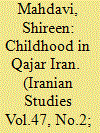

|
|
|
|
|
| Publication |
2014.
|
| Summary/Abstract |
The history of children in general and that of Persian children in particular is that of the inarticulate. The social history of Iran is a neglected field although in recent decades a preponderance of material has appeared on the history of women. Aside from this no work has been undertaken on the private life of the period including childhood and family life. This article examines various aspects of the position and upbringing of children in Qajar Iran ranging from the rearing of children to their status in the family, discipline, amusements and education. This investigation attempts to cover the childhood of different sexes and social classes both in rural and urban areas. The discussion is limited to Shi'i children, the majority population of Iran.
|
|
|
|
|
|
|
|
|
|
|
|
|
|
|
|
| 2 |
ID:
129010
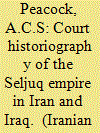

|
|
|
|
|
| Publication |
2014.
|
| Summary/Abstract |
This paper reexamines the Arabic and Persian historical literature of the Seljuq period (1040-1194), concentrating on works produced in circles connected with the sultanic court. It considers the relationship between the Arabic and Persian works, the authors' motives for composition, and the reasons for choice of language. It also compares these works with their predecessors, especially the historiography of the Ghaznavid court, with a view to assessing the particular characteristics of Seljuq historical writing, which is often considered rather slight and unimpressive. One reason that is often adduced for this is the absence of dynastic history writing under the Seljuqs, and the alleged lack of interest of the Seljuq court in patronizing historiography, themes which we also investigate here.
|
|
|
|
|
|
|
|
|
|
|
|
|
|
|
|
| 3 |
ID:
129004
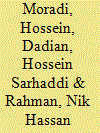

|
|
|
|
|
| Publication |
2014.
|
| Summary/Abstract |
This paper consists of some of the findings of the authors during their research at prehistoric sites of Bampur and its surrounding areas in August 2011. These areas, which have been introduced as Bampur-related sites, comprise an area about of 5-10 kilometers and belong to the Bronze Age. The paper introduces, categorizes and analyzes the archaeological findings in relation to the Bampur collection. The archaeological findings show that: (1) unlike the previous belief, there existed a peak settlement dated back to the Chah Husseini period which was prior to Bampur I; (2) in fact, Bampur II-IV had larger populations due to growth of trade and commerce and their relations with Yahya and Mesopotamia; (3) the later periods of the Bampur collection show a decreasing number of sites at Bampur VI.
|
|
|
|
|
|
|
|
|
|
|
|
|
|
|
|
| 4 |
ID:
129002
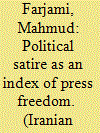

|
|
|
|
|
| Publication |
2014.
|
| Summary/Abstract |
Political satire has had a prominent part to play in the social and political sphere of journalism in Iran since the appearance of an independent press in the country at the beginning of the twentieth century. This paper examines the problems of political satire in the Iranian press during the 2000s with respect to their historical context during the past century. The paper argues that, addressing the essential relationship between satire and criticism, and the primary role that criticism has in the freedom of press, what happened to political satire and satirists in Iran can be seen as an index of the freedom of the press and journalistic expression for an era.
|
|
|
|
|
|
|
|
|
|
|
|
|
|
|
|
| 5 |
ID:
129015
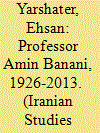

|
|
|
|
|
| Publication |
2014.
|
| Summary/Abstract |
Professor Amin Banani was one of the pillars of Iranian Studies in the United States and his passing leaves a conspicuous and regrettable gap in providing instruction and guidance with respect to Iranian history and Persian literature. He could speak with authority about the entire field of Iranian Studies, even though his expertise did not extend to pre-Islamic Iranian languages and religions.
|
|
|
|
|
|
|
|
|
|
|
|
|
|
|
|
| 6 |
ID:
129003
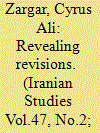

|
|
|
|
|
| Publication |
2014.
|
| Summary/Abstract |
This article examines four mystical treatises by the Safavid scholar Fayd al-K?sh?n? (d. 1090/1679). Of the four, al-Kalim?t al-Makn?na ("the Hidden Words") serves as the basis for the three other versions, al-La'?li', Qurrat al-'Uy?n, and al-Kalim?t al-Makhz?na, composed at different times for different audiences. Comparison of their structure and content reveals changes that occurred in K?sh?n?'s presentation of the thought of Ibn 'Arab? and Mull? Sadr?. K?sh?n?'s later emphasis on Shi'i hadith sources says much about the context in which he wrote and perhaps more about his later assessment of the place of sufi cosmology, Islamic philosophy, and scripture in scholarly and popular circles.
|
|
|
|
|
|
|
|
|
|
|
|
|
|
|
|
| 7 |
ID:
129001
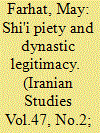

|
|
|
|
|
| Publication |
2014.
|
| Summary/Abstract |
Mashhad, the site in northeastern Iran of the shrine of the eighth Shi?i imam, is arguably one of the largest and wealthiest sacred shrines in the world. The gilded dome over the imam's mausoleum stands amidst an expansive complex of courts, monumental gateways, libraries, museums, guesthouses, and administrative offices that cater to thousands of pilgrims each year. This paper examines the period, under the aegis of the early Safavid shahs, when Mashhad was established as the preeminent Shi?i pilgrimage center in Iran. Appropriating the Timurid ecumenical vision for the shrine, the Safavid shahs refashioned the holy city into a site that celebrated the triumph of Twelver Shi?ism in the Safavid realm and reinforced Safavid claims of legitimacy. While highlighting Shah Tahmasb's personal devotion to Mashhad, and his privileging of the shrine within Safavid sacred topography, the paper focuses on Shah ?Abbas's urban reshaping of Mashhad and the architectural and institutional expansion of the shrine during his reign, thereby enhancing its status as the leading spiritual center in the Safavid empire.
|
|
|
|
|
|
|
|
|
|
|
|
|
|
|
|
| 8 |
ID:
129006
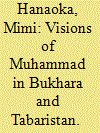

|
|
|
|
|
| Publication |
2014.
|
| Summary/Abstract |
Persian authors couched claims to the religio-political authority and legitimacy of their cities through dream narratives in local histories written between the tenth and thirteenth centuries. Persians did not always fit neatly into genealogical claims to legitimacy like the Arab descendants of Mu?ammad and his clan, and dreams form alternate avenues that sanctify and legitimate specific Persian cities and individuals. Dream narratives embedded in T?r?kh-i Bukh?r? and T?r?kh-i ?abarist?n are literary devices that bring the prestige of religious authority to their city and province and to specific persons. These dream narratives are not only windows into understanding the broader social, political, and religious contexts of local histories but also the particular anxieties and priorities of the authors.
|
|
|
|
|
|
|
|
|
|
|
|
|
|
|
|
|
|
|
|
|